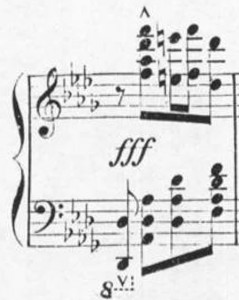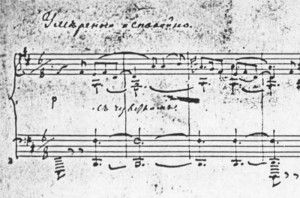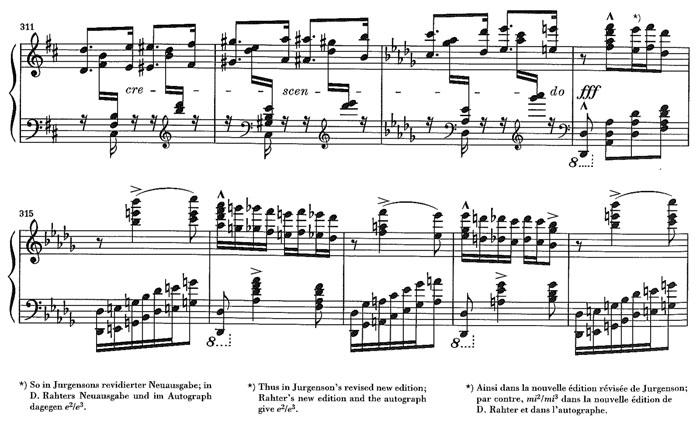Mily Balakirev’s showpiece Islamey, already certified, so to speak, as unplayable by the dedicatee Nikolai Rubinstein, is also still today amongst piano virtuosi’s most brilliant warhorses. The two central melodies – sparking around them here is an almost mechanically effective fireworks display with its ever-present note repetitions – derive from the folk music of the Circassians and Crimean Tartars. And so the whole piece makes a relatively ‘exotic’ impression on classically trained ears.
Balakirev proved to be in his writing of the work and also especially during its publication an extremely painstaking and diligent composer – not something to be taken for granted, indeed, as we Urtext editors know from painful experience. Provided with the essential sources for the Islamey music text and thanks to several important documents from his correspondence with publishers, we can fully and impressively document the rather complicated publication history and Balakirev’s diligence. Yet, it is just at the furious climax of the piece, singularly marked fff (in m. 314), that doubts arise about how to interpret the music text …
Thus:
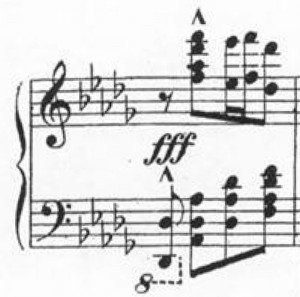 Beyond question, this is no trifling matter. It has to do with Islamey’s second central theme that an Armenian actor divulged to Balakirev. He made a note of the melody on a leaf that today is preserved in the Russian National Library in Moscow:
Beyond question, this is no trifling matter. It has to do with Islamey’s second central theme that an Armenian actor divulged to Balakirev. He made a note of the melody on a leaf that today is preserved in the Russian National Library in Moscow:
 The crucial measure is the first. How are we to interpret the g1? As a passing note from a1 to the tonic note f1, with a1 as a neighbouring note in between, or is it a lower changing note to the twice-given a1 that then jumps down a third to the tonic? Both meanings are in principle possible. If, however, we consider the seven measures of the 1st section of the theme overall, then the appropriately consistent step-wise descending progression of the phrase suggests identifying it as passing note to f1.
The crucial measure is the first. How are we to interpret the g1? As a passing note from a1 to the tonic note f1, with a1 as a neighbouring note in between, or is it a lower changing note to the twice-given a1 that then jumps down a third to the tonic? Both meanings are in principle possible. If, however, we consider the seven measures of the 1st section of the theme overall, then the appropriately consistent step-wise descending progression of the phrase suggests identifying it as passing note to f1.
Here are several concise passages from the autograph:
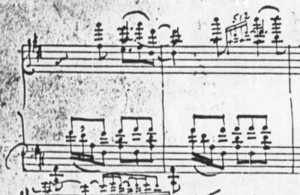
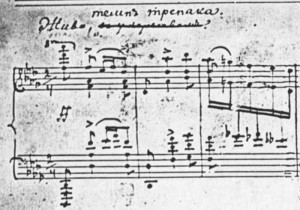 The kicker then comes, though, in the autograph at the final and most vigorous climax. Here Balakirev interprets (in D-flat major) the second note not only as a changing note to f2, but by raising it to the minor second gives it additional leading-tone character. A rousing shock effect at the proper place:
The kicker then comes, though, in the autograph at the final and most vigorous climax. Here Balakirev interprets (in D-flat major) the second note not only as a changing note to f2, but by raising it to the minor second gives it additional leading-tone character. A rousing shock effect at the proper place:
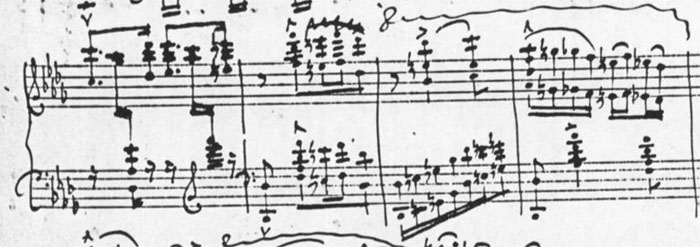 Composed in 1869, the piano fantasy Islamey straightaway appeared the following year from the Moscow publisher P. Jurgenson; here we see the relevant place as would be expected from the text. The first print is after all – as already mentioned above – very carefully engraved, and there is no doubt that Balakirev was intensively involved in the publication (in the galley proofs he even added several more ossia bars).
Composed in 1869, the piano fantasy Islamey straightaway appeared the following year from the Moscow publisher P. Jurgenson; here we see the relevant place as would be expected from the text. The first print is after all – as already mentioned above – very carefully engraved, and there is no doubt that Balakirev was intensively involved in the publication (in the galley proofs he even added several more ossia bars).
From this point on, the further publication history of this work now becomes somewhat confusing. As early as 1888 Jurgenson sold the Islamey rights to the Hamburg (later Leipzig) publisher, D. Rather. The latter published in 1902 an entirely re-engraved edition of the piece bearing on the title page the notice, ‘nouvelle édition revue et corrigée par l’auteur’. Balakirev had rechecked the music text for this edition, correcting, expanding and providing it with, amongst other things, metronome markings and two more ossias. This did not result in any change in the passage of interest to us, that is, it agrees with the text of the Jurgenson first edition. This is the way the music looks as it is still being sold today by Rather’s legal successor, Boosey & Hawkes (Elite Edition 3109).
Yet as we know today, this is not the ‘definitive version’, after all! Because in 1909 there then appeared in the Jurgenson publishing house in Moscow yet another new edition of the fantasy resulting from another revision by Balakirev. As early as in January 1908, Boris P. Jurgenson wrote Balakirev: ‘Today I happen to have learned from a conservatory teacher that Rather has published a new edition of “Islamey” with your corrections and changes. I consider it necessary to have these corrections and changes in our edition, too, and am therefore sending you an exemplar of “Islamey” with the request to do for it what you have done for Rather.’ (Thanks to Felix Purtov for the German translation of this letter in Russian.) The further correspondence with Jurgenson documents that Balakirev complied with his request and then got as well two sets of galleys for proofreading the new engraving, reset in Moscow according to his wishes. Once again there emerged a very carefully and nearly flawlessly realized music text. The climax in m. 314, though, now reads thus:
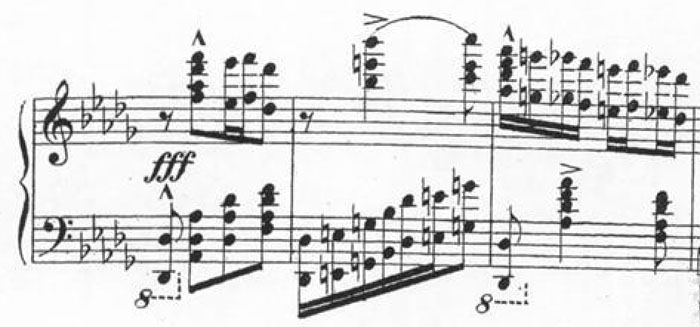 By mistake? Or on purpose? How are we to decide? Considering the fact that – as already now repeatedly mentioned – through all the text stages Balakirev has characteristically been a meticulous steward of his wishes, I have made the decision in our Urtext edition (HN 793) to edit it as e flat instead of e, as called for by the ‘definitive version’. Musically, though, I feel this ‘strict’ repetition of the melody is weaker, but on the basis of what has been said, I cannot believe that it is an engraving error.
By mistake? Or on purpose? How are we to decide? Considering the fact that – as already now repeatedly mentioned – through all the text stages Balakirev has characteristically been a meticulous steward of his wishes, I have made the decision in our Urtext edition (HN 793) to edit it as e flat instead of e, as called for by the ‘definitive version’. Musically, though, I feel this ‘strict’ repetition of the melody is weaker, but on the basis of what has been said, I cannot believe that it is an engraving error.
And so it only remains for you to form your own opinion with the help of our edition!

